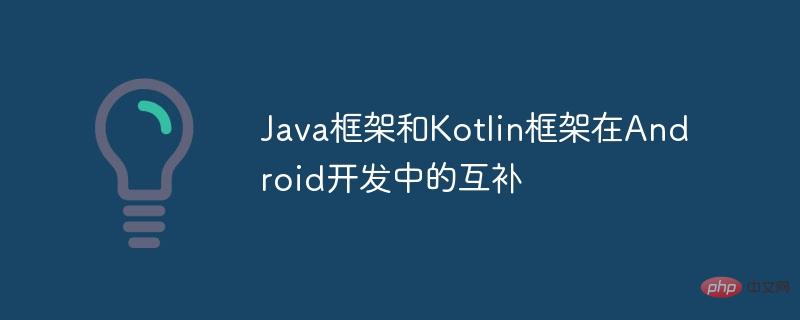Home >Java >javaTutorial >Complementarity between Java framework and Kotlin framework in Android development
Complementarity between Java framework and Kotlin framework in Android development
- WBOYWBOYWBOYWBOYWBOYWBOYWBOYWBOYWBOYWBOYWBOYWBOYWBOriginal
- 2024-06-02 21:21:00759browse
In Android development, the clever combination of Java framework (mature and stable, cross-platform, large-scale project support) and Kotlin framework (modern syntax, extension functions, coroutine support) can play complementary advantages: Java handles network requests and business logic, and Kotlin Responsible for user input and validation, while taking advantage of Java and Kotlin to create efficient and easy-to-maintain applications.

The complementary advantages of Java framework and Kotlin framework in Android development
In the field of Android development, Java and Kotlin frameworks go hand in hand. Each has its own characteristics and advantages. Cleverly combining these two frameworks can give full play to their complementary advantages and improve development efficiency and application quality.
Advantages of Java framework
- Mature and stable: Java has been used in Android development for many years and has rich libraries and resources. The ecosystem is very complete.
- Cross-platform: Java code can be easily ported to other platforms, facilitating cross-platform application development.
- Large project support:The Java framework is more suitable for large and complex projects, providing a robust architecture and scalability.
Advantages of Kotlin framework
- Modern syntax: Kotlin is a modern language with concise and clear syntax, making it easier to read Write.
- Extension functions: Kotlin supports extension functions, which can extend the functions of the standard library as needed and improve the readability and maintainability of the code.
- Coroutine support: Kotlin has built-in support for coroutines, which makes it easy to write asynchronous, non-blocking code and improve application response speed.
Practical case: Complementary use of Java and Kotlin frameworks
Taking a simple user login function as an example, we can use these two frameworks in combination:
// Kotlin代码:处理用户输入和验证
class LoginFragment : Fragment() {
override fun onCreateView(...) {
val viewModel = ViewModelProviders.of(this).get(LoginViewModel::class.java)
binding.loginButton.setOnClickListener {
// Validating input using standard Java libraries
if (binding.usernameInput.text.isEmpty() || binding.passwordInput.text.isEmpty()) {
Toast.makeText(context, "Empty fields", Toast.LENGTH_SHORT).show()
} else {
viewModel.loginUser(binding.usernameInput.text.toString(), binding.passwordInput.text.toString())
}
}
}
}
// Java代码:处理网络请求和业务逻辑
class LoginViewModel extends ViewModel {
private val repository = LoginRepository()
fun loginUser(username: String, password: String) {
repository.login(username, password)
.observeForever { result ->
if (result.isSuccess) {
// Navigate to the home activity using Java APIs
startActivity(new Intent(context, HomeActivity::class.java))
} else {
// Show an error message using Kotlin extension functions
context?.showToast("Login failed")
}
}
}
}In this example, the Kotlin code handles user input and validation, utilizing clear and readable syntax and extension functions. The Java code is responsible for network requests and business logic, providing mature libraries and robust architecture.
Through this complementary use, you can simultaneously take advantage of the stability of the Java framework and the modern advantages of the Kotlin framework to create efficient and easy-to-maintain Android applications.
The above is the detailed content of Complementarity between Java framework and Kotlin framework in Android development. For more information, please follow other related articles on the PHP Chinese website!
Related articles
See more- How to convert string into character array in java
- How to read files in java
- How to use java random number random
- A new version of WeChat's full-platform terminal database WCDB is open source, with new support for C++ and Kotlin
- What is the difference between Java functions and Kotlin language functions?

